We are no longer building saddle trees, but we have two videos about how Western saddles fit horses available on our westernsaddlefit.com website.
Seat Length and Thigh Length Relationships
Measuring room for the rider
The traditional measurement used to determine the amount of room in the saddle for the rider is the seat length. It is supposed to tell you how much distance there is between the fork and the cantle for the rider’s body to fit into. As explained in our Measuring a Saddle Tree page, we measure seat length from the top of the cantle to the top of the hand hole. But if the rider actually contacts either of those points when riding, something is wrong! A much more useful measurement is how much room there is between the fork and the cantle along the bar where the rider’s leg goes. We call this thigh length and measure it from the point of the cantle horizontally forward to the nails at the back of the fork. The amount of room there is vital to how well the rider fits into the saddle.
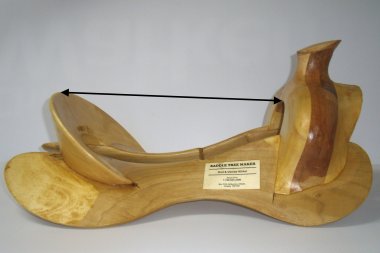 |
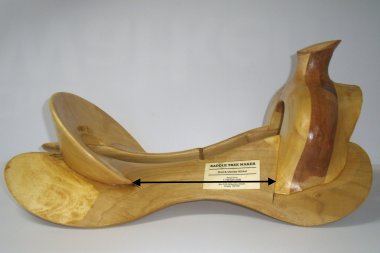 |
| Seat Length | Thigh Length |
The measurement rarely mentioned - Government Length
Since these measurements are really trying to determine the distance between the fork and cantle, how do we figure out where to join them to the bars? We (and most hand makers we know that make a cantle cut as well as a fork cut) use something traditionally called the government measurement or government length, because it governs everything else in the tree. We learned the correct term from Warren Wright, a tree maker in New Zealand who has done a lot of research into saddle tree history. In talking with other hand makers, we found that while all use it, we all had different names for it because we didn’t know it had a traditional name! This is the distance we mark on the inside of the bar to set the distance between the fork and cantle cuts, and which varies to make the different tree lengths. (Note: if a tree maker doesn’t use cantle cuts, they have no need of a government measurement. They just attach the cantle to the bars wherever the seat length measures properly. However, the same relationships of seat length and thigh length described below still apply.) Since we have the same length of bar behind the cantle cut on all our trees and one of two measurements ahead of the fork cut, depending if they are regular or Wade bars, the government length varies consistently with bar length. So long as we don’t change the angles of the fork and cantle cut and we always measure in the same place, the government length also varies consistently with the thigh length. It does not, however, correlate to seat length unless the tree maker changes other components to force it to do so. We prefer to give you as a customer the options available in these components so you can get the look you want, but this means that the thigh length is not the same for all seat lengths in our trees. However, since we know the correlations between all three measurements, we can help you get what you need for size with the look you want.
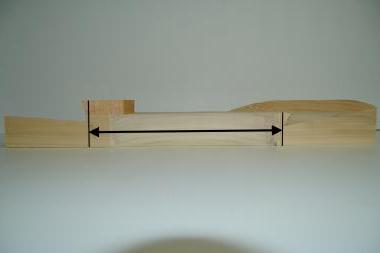 |
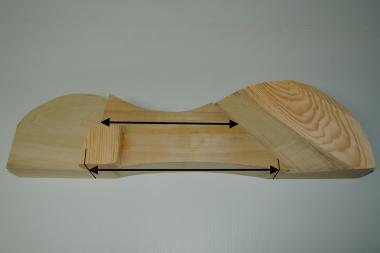 |
| Government length | Government length and thigh length correlate |
Factors affecting seat length
There are three main factors that change the measured seat length without changing the position of the fork and cantle on the bars (the government length): cantle height, cantle angle and hand hole height.
1.) Cantle height
This is the factor that makes the biggest difference, because the cantle leans away from the fork significantly. As it goes up, it also goes back, farther away from the fork, which increases the seat length measurement without changing the room in the saddle for the rider at all. To get the same seat length with a taller cantle, the cantle must move forward on the bars, decreasing the thigh length and the room in the saddle for the rider.
For short cantles, the seat length measurement decreases compared to taller cantles and you have to move the cantle back on the bars to keep it the same, increasing the thigh length and room for the rider. Changing the cantle height 1 ½ inches can change the thigh length 1 ¾” with the same seat length. Considering that most people fit within a 2” spread in the thigh length (8” to 10”) that is a considerable difference.
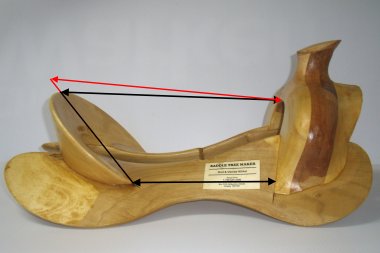 |
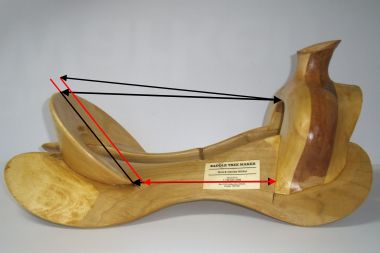 |
| The seat length gets longer when the cantle gets taller if nothing else changes. | To keep the same seat length with a taller cantle, the government length must decrease, which decreases thigh length. |
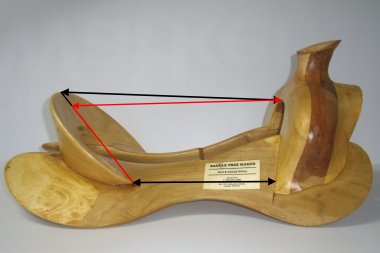 |
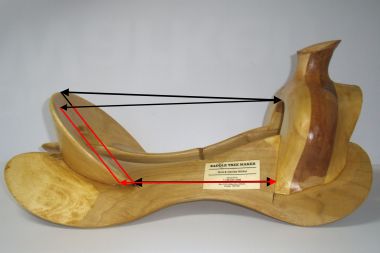 |
| The seat length decreases when the cantle gets shorter if nothing else changes. | To keep the same seat length with a shorter cantle, the government length must increase, which increases thigh length. |
2.) Cantle angle
This can make up to ¾” difference in thigh length for the same seat length on our trees depending on cantle height and amount of angle change. As you stand up a cantle, the top gets closer to the fork which decreases the seat length without changing where the cantle is connected to the bars. Leaning it back more increases seat length. To keep the same seat length when you stand up a cantle, the bottom of the cantle needs to be moved back on the bars, increasing the thigh length. When you lean a cantle back but keep the same seat length, its base is moved forward, decreasing the thigh length.
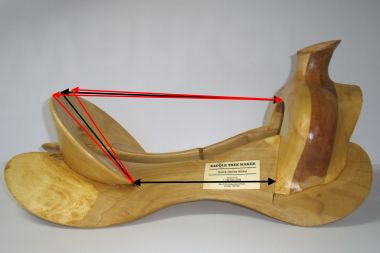 |
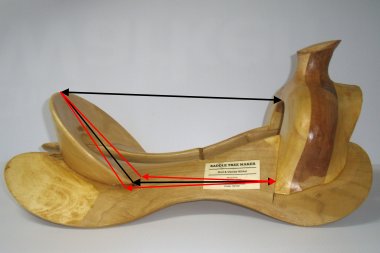 |
| Changing the cantle angle changes the seat length if the government and thigh lengths remain the same. |
To keep the same seat length when the cantle angle is changed, the government length must change, which changes thigh length. |
3.) Hand hole height
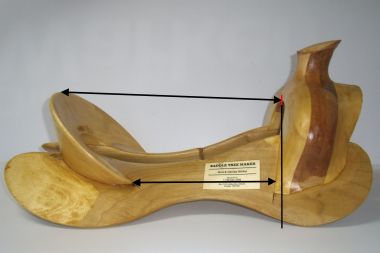
While you would think that this would have the same sort of effect as cantle height, in practice we have found we can pretty much disregard it, probably because the angle on the fork is relatively straight compared to the cantle and also because the variation in hand hole height is relatively small. Whatever variation is caused by this change is small enough it doesn’t affect the final measurements within the 1/8” increments that we use.
Factors affecting thigh length
There are two changes that can be made to the cantle that change the measured thigh length without changing the position of the fork and cantle on the bars (the government length): width of the cantle across the points and leg cut.
1.) Width of the cantle across the points
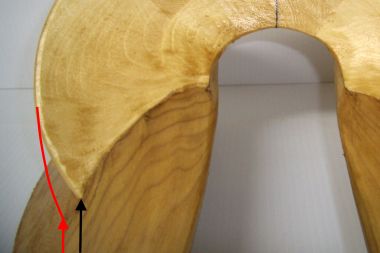
If none of the angles are changed, as the points of the cantle go farther apart they also go forward, decreasing thigh length. This is why, depending on how the maker shapes his cantles, a tree with a wider cantle might have less thigh room than a tree with a narrower cantle. We make the width between the points consistent on all our cantles so this isn’t a factor we have to deal with. However, if you ask for a change to be made here we are able do it and we will discuss with you the ramifications of the change.
2.) Leg cut on the cantle
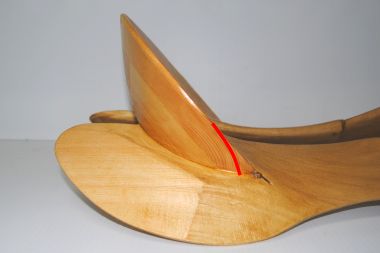
Trimming back the front corner on deep dished cantles removes the rubbing some people may experience there. (Whether that happens or not depends on how the ground seat is built and the conformation of the rider.) Doing this only changes what you measure as thigh length. Since it doesn’t change the position of the fork or the cantle on the bars (the government length), it doesn’t put the rider’s leg farther back from the fork. It just keeps that front corner of the cantle from rubbing. (Of course this also depends on how you use the pattern.)
The effect of changing the fork cut angle
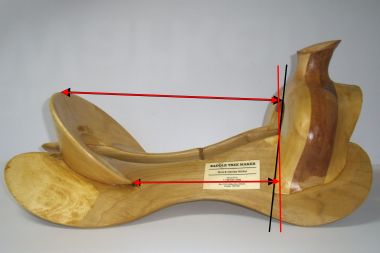 To change the fork angle, we change the angle of the fork cut on the bars (plus some other things). Practically what results is that the fork rotates around the upper edge of the bar where we initially mark out the government length. This affects both thigh length and seat length, but in opposite directions. With the same government length, when a fork is stood up the seat length shortens and the thigh length lengthens. On our trees, this will make about a ¾” change in the difference between the two measurements from the same tree with the fork leaned ahead.
To change the fork angle, we change the angle of the fork cut on the bars (plus some other things). Practically what results is that the fork rotates around the upper edge of the bar where we initially mark out the government length. This affects both thigh length and seat length, but in opposite directions. With the same government length, when a fork is stood up the seat length shortens and the thigh length lengthens. On our trees, this will make about a ¾” change in the difference between the two measurements from the same tree with the fork leaned ahead.
The effect of changing the cantle cut angle
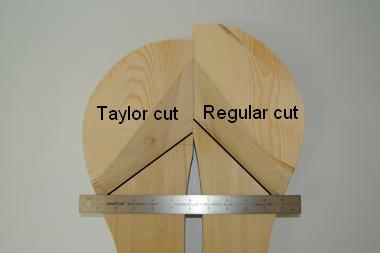
We change our cantle cut angle when we change from a regular to a Taylor cantle. There are other changes made at the same time, so the final result on our trees is that the thigh length and seat length stay almost the same compared to each other, but the government length and therefore the bar length get almost an inch shorter. Please see our Cantle Conundrums page for a fuller explanation.
Determining the thigh length you need
|
Take circumference of thigh Divide by three Add one inch |
Practically, we have found that the majority of adults fit between 8” and 10” of thigh room, though some are outside that range. Dennis Lane, an Australian saddle and tree maker let us in on his rule of thumb to start figuring out the thigh length wanted. Take the circumference of the upper thigh and divide by 3 (close enough to Pi for what we are doing). This gives a ballpark diameter for the rider’s thigh. Then add an inch. This gives you the starting point for figuring out thigh length. You then want to consider the style of the fork – the rider’s leg can go farther forward on a slick fork than a swell fork, and undercut on a swell fork like an Old Moose gives them more room. You also want to note if they want bucking rolls or not on a slick fork. How you position the bucking rolls also may affect how you order. Different sports have different requirements. Cutters like longer seats. Calf ropers like them shorter. Some riders like to ride with shorter stirrups, so their leg is angled more forward. They need more room in the saddle than if they rode with their leg straighter. And then some people just like to have lots of room or be tight in the saddle. All these things need to be taken into account when determining thigh length, just as they do if you were to order a seat length, but we have found Dennis’s rule of thumb to be a good place to start.
A caution regarding measuring a finished saddle
A seat length measurement taken on a finished saddle will be shorter than that taken on the tree by the thickness of the leather used on the back of the fork and the front edge of the cantle. But a measurement taken between the front corner of the cantle and where you envision the back of the fork to be on a finished saddle will measure a fair amount larger than the thigh length measured on a tree. With all the rigging and jockeys in place, you are measuring much higher up on a finished saddle and since the fork and cantle lean away from each other, the measurement will be longer. This more than compensates for the leather thickness. Depending on how you build your saddles (and how well you keep records) over time you may be able to correlate a measurement you take on your saddles to what the original thigh measurement on the tree was. But you can’t just measure a finished saddle, give us that number for thigh length and expect it to work. It will end up being way too big for that customer.
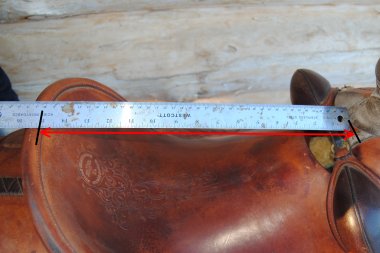 |
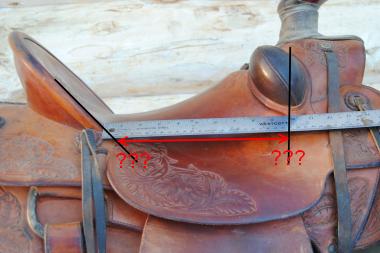 |
Ordering by thigh length
We take orders for seat length OR thigh length, and we can let you know what the other one will measure based on the rest of your specs. You cannot order both along with cantle height, angle, etc. The geometry just doesn’t work that way. Some tree makers may not use the concept of thigh length while other tree makers work very hard to get their seat length and thigh length to correlate as much as possible, so they only take orders by seat length. You need to work with what your tree maker uses, because they know how they build their trees. Because we like to give our customers as many options as is practical in terms of cantle angle, etc., thigh length becomes more of an issue. Therefore, ordering by thigh length instead of seat length is one of the options we provide.
What actually matters
The distance that really matters in terms of room for the rider is how far back any part of their torso can go (preferably the center of the face of the cantle) and how far forward any part of their torso can go (determined either by the fork, the bucking rolls or, uncomfortably, a poorly designed rise in the seat). Also, the position of the low point on the seat where the pin bones will end up (gravity still works) relative to the fork and the cantle is also important. But the real room in the saddle can’t actually be measured consistently since it has to do with shape of the seat as much as a measurement. This is why we say that getting the right size saddle is like a woman buying clothing: You have to try it on to see if it fits you! However, we consider thigh length to be a closer guesstimate of saddle size than seat length.
